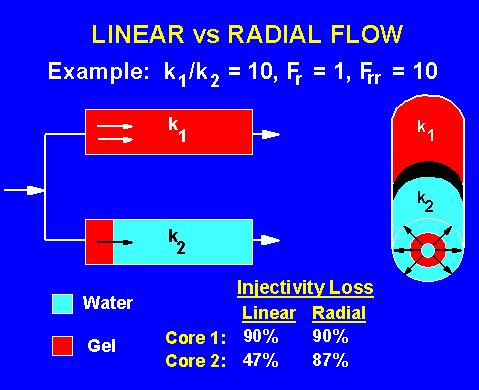Is the Problem Caused by Fractures or Fracture-Like Features?
A critical aspect of diagnosing most excess water production problems is deciding whether fluid flow around the wellbore is radial or linear. Flow behind pipe, fractures, and fracture-like features are associated with linear flow, while radial flow generally occurs in matrix reservoir rock when these features are absent. (We recognize the special case of radial flow in fractures, e.g., for vertical fractures that cross horizontal wells. This case will be treated separately later. In this section, our consideration of radial flow is confined to flow in matrix, while linear flow refers to the presence of extremely permeable fracture-like features.) Simple calculations using the Darcy equation reveal that the approach for solving these linear flow problems must be fundamentally different than solving radial flow problems in matrix reservoir rock or sand.17 Especially for gel treatments, linear versus radial flow problems differ radically in
- gel properties desired,
- placement procedures required, and
- optimum volume of the gel placed.

A number of methods are available to judge whether flow around a wellbore is linear (in fracture-like features) or radial (in matrix rock or sand). One simple method4 uses the Darcy equation for radial flow (Eq. 1).
q/Δp = Σ kh / [141.2 μ ln (re /rw)]
If the actual injectivity or productivity for a well (i.e., the left side of Eq. 1, q/Δp, in BPD/psi) is five or more times greater than the injectivity or productivity calculated using the Darcy equation for radial flow (i.e., the right side of Eq. 1), the well probably suffers from a linear flow problem.
Linear Flow:
q/Δp >> Σ kh / [141.2 μ ln (re /rw)]
On the other hand, if the left side of Eq. 1 is less than or equal to the right side, radial flow becomes likely.
Radial Flow:
q/Δp ≤ Σ kh / [141.2 μ ln (re /rw)]
In the above equation, k is effective rock permeability in md. If the zone contains water at residual oil saturation (Sor), k should take this into account. Typically the water relative permeability at Sor is between 5% and 30% of the absolute permeability, with 10% being a good estimate if k at Sor is not known. If the zone is producing only oil, k can be taken as the absolute permeability without incurring much error in the calculation. The permeability used in Eq. 1 should be taken from core analyses, log data, or pressure transient analyses. It should not be taken from production data. Net pay, h, in Eq. 1 has units of feet, while viscosity, m, has units of cp. If the well is a water injector or if the well is producing a very high water cut, then the viscosity of water can be used (at the appropriate temperature). If the oil cut is significant, there may be value in performing two calculations using Eq. 1, one using water viscosity and one using oil viscosity. The natural log term in Eq. 1 can be assumed to have a value of 6 or 7. The pressure drawdown or buildup (Dp, in psi) in Eq. 1 must be reasonably current and applicable to the specific well of interest. It is a mistake to take this value from another well or to use a value that is too old. This pressure difference indicates a great deal about the problem of the specific well and is extremely important to measure both before and after (and even during) a gel treatment.
Of course, uncertainty exists for a significant range of conditions that do not satisfy either Eq. 2 or Eq. 3. Thus, injectivity/productivity calculations will not always distinguish between radial and linear flow. Nevertheless, they frequently do provide a definitive indication of the flow geometry near the wellbore. Since the calculations are easily performed using data often at hand, they provide a low-cost diagnostic method that should be considered when diagnosing any excess water production problem.
In addition to the injectivity/productivity calculations discussed above, several other methods can be used to determine if fractures or fracture-like features are the source of the water problem. These other methods include
- core and log analyses (especially from highly deviated or horizontal wellbores),
- pulse tests/pressure transient analyses, and
- interwell tracer studies.
Various logging methods have been used to detect and characterize fractures (Chapter 3 of Ref. 18). However, these methods must be used with caution since they usually measure properties at or near the wellbore. The value of these methods can be increased if the wellbore is deviated to cross the different fracture systems (i.e., fractures with different orientations).
Pressure transient analyses have often been used to characterize fractured reservoirs (Chapter 4 of Ref. 18). Reportedly, these methods can estimate the fracture volume, the fracture permeability, and, possibly under some circumstances, the minimum spacing between fractures. Pressure interference tests can also indicate fracture orientation. In addition to unsteady-state methods, steady-state productivity indexes were also suggested as a means to estimate fracture permeability.
Interwell tracer studies provide valuable (and often relatively inexpensive) characterizations of fractured reservoirs, especially for use in judging the applicability of gel treatments to reduce channeling.19,20 Interwell tracer data provides much better resolution of reservoir heterogeneities than pressure transient analyses.20 Tracer results can indicate
- whether fractures or fracture networks are probably present and if those fractures are the cause of a channeling problem,
- the location and direction of fracture channels,
- the fracture volume,
- the fracture conductivity, and
- the effectiveness of a remedial treatment (e.g., a gel treatment) in reducing channeling.21